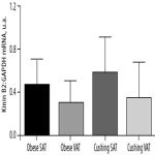Pilot study of gene expression analysis of kinin B1 and B2 receptors in adipose tissue depots of Cushing’s syndrome subjects
Dannylo Wesley Nóbrega de Sousa, Kalil Jacinto Ribeiro, Tabata Oliveira Santos, Israel dos Reis dos Santos, Daniela Espindola Antunes, Claudio Kater, Luis Vicente Franco Oliveira, José Antonio Silva Júnior
Med Sci Tech 2012; 53(2): RA53-57
ID: 883574
Available online:
Published: 2012-11-19

Background: Individuals with endogenous or exogenous hypercortisolism develop a pattern of central obesity, which is reversible after treatment or withdrawal of glucocorticoids. The objective of this study was to quantify the expression of kinin B1 and B2 receptors in fat deposits in patients with Cushing’s syndrome and obese subjects.
Material/Methods: Samples of subcutaneous (SAT) and visceral adipose tissue (VAT) were obtained during abdominal surgery in female patients with Cushing’s syndrome (n=5) and obese subjects (n=7). mRNA expression was quantified by real-time PCR.
Results: Kinin B1 receptor expression was increased in VAT than in SAT in obese subjects (p<0.05). Likewise, the expression of kinin B1 receptor was also increased in VAT than in SAT of patients with Cushing’s syndrome (p<0.05). mRNA expression of kinin B2 receptor in SAT and VAT in Cushing’s syndrome patients was not different between both fat deposits (p>0.05). No difference of kinin B2 expression was observed between SAT and VAT in obese subjects and also was not significantly different from Cushing’s subjects.
Conclusions: Our data suggest that chronic hypercortisolism is related to the higher amount of kinin B1 receptors in VAT, the fat deposit responsible for obesity-related complications and increased mortality. As obese subjects also show increased kinin B1 receptors in VAT, this receptor might be involved in the obesity signaling pathway.
Keywords: Kinins, Adipose Tissue, Cushing’s syndrome



